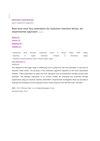基于机器学习和图像处理的番茄植物健康状况快速准确分类方法
IF 0.9
4区 工程技术
Q4 ENGINEERING, ELECTRICAL & ELECTRONIC
引用次数: 2
摘要
农业对经济增长和发展至关重要,保持高质量、无病的植物对其成功至关重要。植物病害可由环境因素、真菌、细菌和病毒引起,及早发现病害对于实施适当的治疗至关重要。西红柿是最重要的粮食作物之一,易受病害的影响,这些病害会给农业造成重大经济损失。本文介绍了一种利用图像处理技术和机器学习算法来评估番茄叶片健康状况的方法。从土耳其萨姆松省和梅尔辛省的番茄种植区收集了1778张健康和受感染番茄叶片图像的数据集。使用16种先进的机器学习算法进行分类,并使用网格搜索方法确定每种算法的最优超参数。分类器在Jetson Nano和TX2嵌入式系统上运行。实验结果表明,随机森林分类器在检测和分类番茄叶片健康状况方面优于其他算法,准确率约为99%。拟议中的系统能够更快、更准确地进行检测,使农民能够将植物分类为受感染的还是健康的,最终改善治疗和病虫害管理策略的决策。本文章由计算机程序翻译,如有差异,请以英文原文为准。
A Fast and Accurate Method for Classifying Tomato Plant Health Status Using Machine Learning and Image Processing
Agriculture is crucial to economic growth and development, and maintaining high-quality, disease-free plants is crucial to its success. Early detection of plant diseases, which can be caused by environmental factors, fungi, bacteria, and viruses, is essential to implement appropriate treatments. Tomatoes, which are one of the most vital food crops, are susceptible to diseases that can result in significant economic losses in agriculture.
This study introduces a method to evaluate the health of tomato leaf using image processing techniques and machine learning algorithms. A dataset of 1,778 images of healthy and infected tomato leaves was collected from tomato planting areas in the Turkish provinces of Samsun and Mersin. Sixteen advanced machine learning algorithms were used for classification, and the optimal hyperparameters for each algorithm were determined using a grid search approach. The classifiers were executed on Jetson Nano and TX2 embedded systems.
The experimental results indicate that the Random Forest classifier outperformed other algorithms, achieving approximately 99 % accuracy in detecting and classifying the health status of tomato leaves. The proposed system enables faster and more accurate detection, allowing farmers to classify plants as infected or healthy, ultimately improving decision-making on treatment and pest management strategies.
求助全文
通过发布文献求助,成功后即可免费获取论文全文。
去求助
来源期刊

Elektronika Ir Elektrotechnika
工程技术-工程:电子与电气
CiteScore
2.40
自引率
7.70%
发文量
44
审稿时长
24 months
期刊介绍:
The journal aims to attract original research papers on featuring practical developments in the field of electronics and electrical engineering. The journal seeks to publish research progress in the field of electronics and electrical engineering with an emphasis on the applied rather than the theoretical in as much detail as possible.
The journal publishes regular papers dealing with the following areas, but not limited to:
Electronics;
Electronic Measurements;
Signal Technology;
Microelectronics;
High Frequency Technology, Microwaves.
Electrical Engineering;
Renewable Energy;
Automation, Robotics;
Telecommunications Engineering.
 求助内容:
求助内容: 应助结果提醒方式:
应助结果提醒方式:


